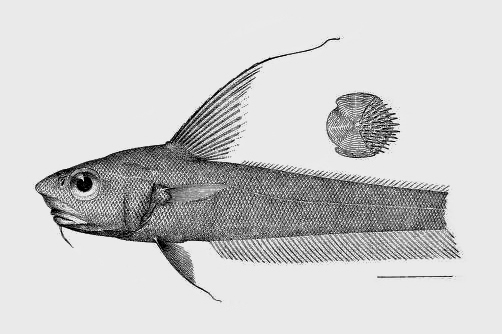- Classification
- ACTINOPTERYGII
- GADIFORMES
- MACROURIDAE
- Nezumia
- infranudis
Nezumia infranudis (Gilbert & Hubbs 1920)

Illustration of the holotype of Nezumia infranudis (described as Lionurus infranudis) - USNM 82669. Source: Gilbert & Hubbs 1920:555, Fig. 38 [Bull. U. S. Natl Mus No. 100, 1( 7)] / Biodiversity Heritage Library. License: CC by Attribution
Summary:
A very rare grenadier known only from two specimens, including one collected in the Timor Sea, northwest of Bathurst Island, Northern Territory.
Cite this page as:
Dianne J. Bray, Nezumia infranudis in Fishes of Australia, accessed 10 Jul 2025, https://fishesofaustralia.net.au/Home/species/5223
Nezumia infranudis (Gilbert & Hubbs 1920)
More Info
|
Distribution |
Recorded from the Celebes and Timor Seas, at 610-690 m. |
|
Features |
First dorsal fin II, 10-12; Pectoral fin i,21; Pelvic fin 11; Outer gill rakers on 1st arch 7-8; Inner gill rakers on 1st arch 9; Outer gill rakers on 2nd arch 7-8; Inner gill rakers on 2nd arch 8-9; Lateral-line scales 38-39; Scales below midbase of 1st dorsal fin 7.5-9.5; Scales below origin of 2nd dorsal fin 8.5. A species of Nezumia with the following combination of features: pelvic-fin rays 11; body scales covered with long, reclined, needle-like spinules densely scattered over exposed portion, posteriormost spinules extending well beyond scale margin; underside of head almost completely naked; cephalic sensory pores large and prominent, especially on underside of head; teeth in broad bands in both jaws; snout long (31–32% HL), protruding well beyond upper jaw, ventral profile oblique; second spinous ray of first dorsal fin greatly elongated (158–166% HL); first dorsal fin blackish; no prominent dark band encircling trunk Nakayama & Endo 2015). |
|
Similar Species |
Nezumia infranudis is most similar to N. spinosa, and differs from other species in the genus by the following combination of features: pelvic-fin rays 11; body scales covered with long, reclined, needle-like spinules densely scattered over exposed portion; underside of head almost completely naked, with prominent sensory pores; teeth in broad bands in both jaws; snout long (31–32% of head length (HL)), protruding well beyond upper jaw; second spinous ray of first dorsal fin greatly elongated (height of first dorsal fin 158–166% HL); no prominent dark band encircling trunk; first dorsal fin almost uniformly blackish. |
|
Species Citation |
Lionurus infranudis Gilbert & Hubbs 1920, Bull. U. S. Natl Mus. No. 100 1(7): 555, Fig. 38. Type locality: Off Sibuko Bay, east of Sabah, Malaysia, Borneo, Celebes Sea, 4°06′50″N, 118°47′20″E, Albatross station 5586, depth 347 fathoms. |
|
Author |
Dianne J. Bray |
Nezumia infranudis (Gilbert & Hubbs 1920)
References
Gilbert, C.H. & Hubbs, C.L. 1920. The macrouroid fishes of the Philippine Islands and the East Indies. Bulletin of the United States National Museum 100(7): 369-588. PDF at BHL
Iwamoto, T. 1999. Families Macrouridae, Bathylagidae, Moridae, Bregmacerotidae. pp. 1986-1998 in Carpenter, K.E. & Niem, V.H. (eds). The Living Marine Resources of the Western Central Pacific. FAO Species Identification Guide for Fisheries Purposes. Rome : FAO Vol. 3 pp. 1397-2068.
Iwamoto, T. 1990. Family Macrouridae. pp. 90-318 in Cohen, D.M., Inada, T., Iwamoto, T. & Scialabba, N. FAO Species Catalogue. Gadiform fishes of the world (order Gadiformes). An annotated and illustrated catalogue of cods, hakes, grenadiers and other gadiform fishes known to date. FAO Fisheries Synopsis No. 125. Rome : FAO Vol. 10 442 pp.
Nakayama, N. & Endo, H. 2015. Redescription of Nezumia infranudis (Gilbert & Hubbs, 1920), with the first record of the species from the Eastern Indian Ocean (Actinopterygii: Gadiformes: Macrouridae). Marine Biology Research: http://dx.doi.org/10.1080/17451000.2015.1064962 8 pp.

